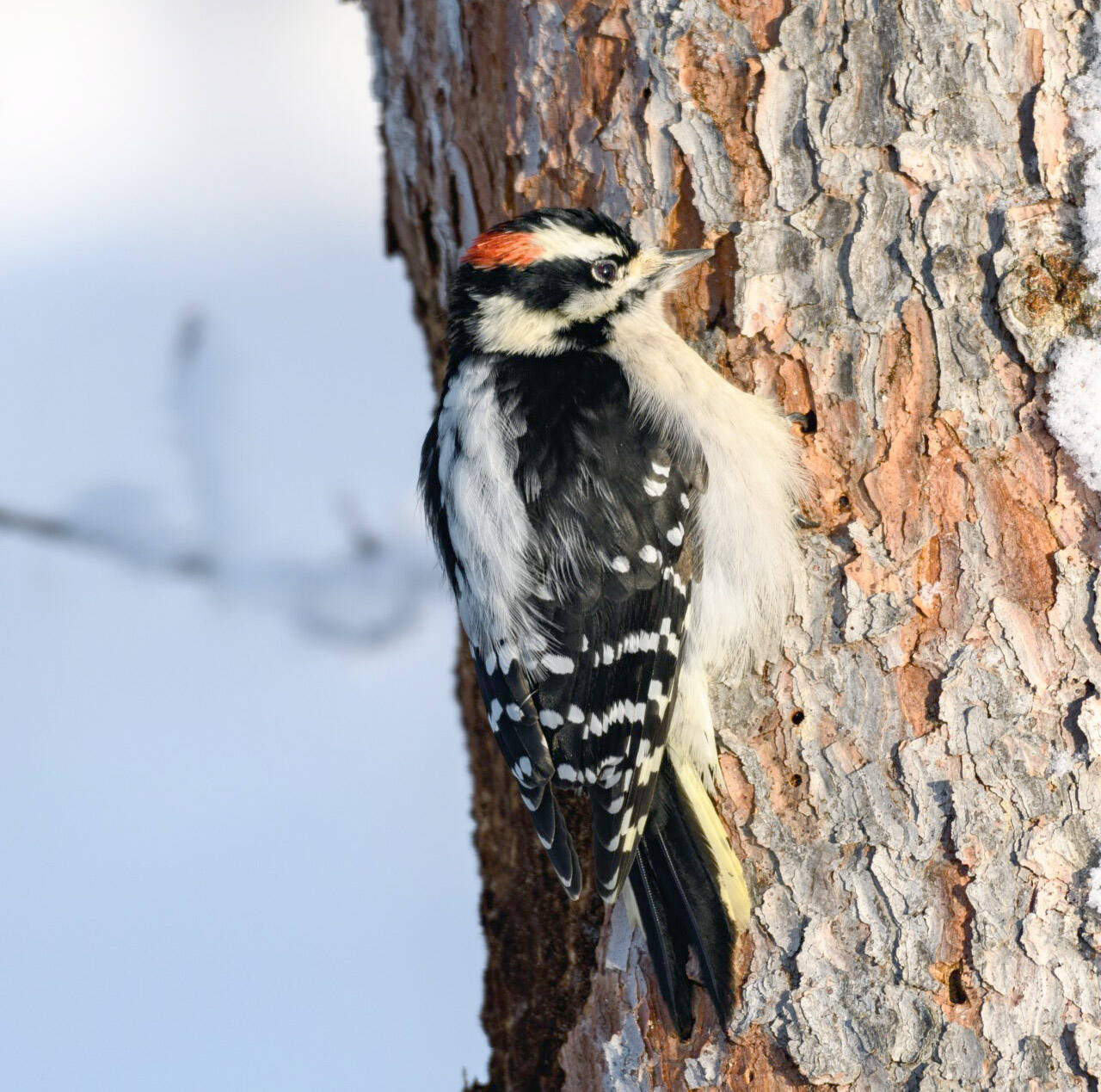I was listening to the distinct sound of a woodpecker drumming a few days ago and caught a flash of a black and white bird. I could not be sure if it was a downy or hairy woodpecker. Both species occur in forested habitats on the Kenai Peninsula. Both forage on insects that live inside wood or tree bark.
Downy and hairy Woodpeckers have nearly identical plumage. Both have a white belly and back that contrast their black- and white-checked wings. Their tails are black with white outer tail feathers with some black spots.
They both have a bold black and white stripe pattern around their eyes. Males of both species also have a small red patch on the back of their heads.
The major difference between these two species is size. Hairy woodpeckers are about the size of an American robin, while the downy is smaller and more similar in size to a dark-eyed junco. The size difference is noticeable when next to one another at a feeder. However, the size difference can be difficult to perceive when distance and movement are in play in the forest.
With practice, there are a few distinctive characteristics beyond size that we can use to identify if it is a downy or hairy.
Bill size is the best indicator. Downy woodpeckers have bills about one-third the length of the head, which appears delicate in comparison with hairy woodpeckers. The hairy’s bill measures nearly as long as their heads and appears chisel-like and extended in comparison to the downy’s bill.
Hairy woodpeckers can have completely white outer tail feathers, but this feature is not foolproof. Black barring on the outer tail feather can occur in Pacific and Newfoundland subpopulations of hairy woodpeckers. In contrast, the outer tail feathers of downy woodpeckers can appear white from certain angles.
Downy and hairy woodpeckers look alike, but strangely they are not closely related. Their genetic lineages split from a shared ancestor over 6 million years ago. Downy woodpeckers are more closely related to the Nuttall’s woodpecker than the hairy woodpecker.
Nuttall’s are currently only in California oak woodlands. Hairy woodpeckers are more closely related to the red-cockaded woodpecker that now only occur in longleaf pine stands in the southeastern United States.
How can two species end up looking more like each other than their closest evolutionary relatives? The answer is mimicry.
Mimicry to avoid being eaten is a well-studied phenomenon. For example, monarch and viceroy butterflies have similar orange and black wing patterns. Both butterflies are purported to taste terrible. Thus, looking like one another is an important survival mechanism in which predators associate the appearance of one unpalatable species with another species.
The advantage of mimicry is different for woodpeckers. Looking alike may benefit downy woodpeckers because they can pass as hairy woodpeckers in some situations. The idea is called interspecific social dominancy mimicry hypothesis.
This theory assumes that smaller species could gain an advantage by mimicking a larger species. For example, downy woodpeckers would avoid aggression and gain habitat and food resources by fooling hairy woodpeckers into thinking they were one of them.
A recent study used citizen scientists’ observations at bird feeders to test if downy woodpeckers avoided attacks by hairy woodpeckers. They found hairy woodpeckers often targeted downy woodpeckers at the feeders, rejecting the advantage of mimicry to avoid hairy aggression.
However, mimicry can have advantages beyond fooling the larger bird they are copying. In the feeder study, downy woodpeckers did seem to weld more dominance over other species than expected based on their size alone. Perhaps the advantage comes from fooling other birds into believing that they are larger? Mimicry could help a smaller woodpecker discourage predators or intimidate competitors.
It turns out that many woodpecker species have a doppelganger all around the world. A 2019 study in Nature Communications found that pairs of woodpecker species with shared plumage were better predicted by range overlap than by genetics, habitat or climate.
In other words, being in the same place at the same time was more influential than other selective pressure to look a certain way. So now, as I listen to drumming in the distance, I wonder if it is a clever downy convincing everyone they are bigger, stronger and more like a hairy, or is it the hairy?
Dr. Magness is a landscape ecologist at Kenai National Wildlife Refuge. Find more information at http://kenai.fws.gov or http://www.facebook.com/kenainationalwildliferefuge.


